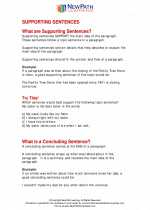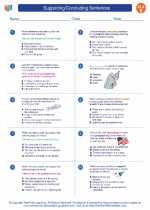Supporting/Concluding Sentences
Supporting and concluding sentences are important elements of a well-structured paragraph. They help to provide coherence and unity to the writing, guiding the reader through the main idea and supporting details.
Supporting Sentences
Supporting sentences provide additional information and details that support the main idea of the paragraph. They give depth and clarity to the topic, and help to convince the reader of the validity of the main point being made.
Example: If the main idea is that "exercise is important for maintaining good health," supporting sentences might include details about different types of exercise, the benefits of regular physical activity, and specific examples of how exercise can improve overall well-being.
Concluding Sentences
Concluding sentences, also known as closing or clincher sentences, are the final statements in a paragraph. They summarize the main idea and bring closure to the topic being discussed. A well-crafted concluding sentence leaves a lasting impression on the reader and reinforces the significance of the main point.
Example: Following the example of the main idea about exercise, a concluding sentence might restate the importance of regular physical activity and encourage the reader to make exercise a priority for better health and wellness.
Study Guide
Here are some tips for mastering the use of supporting and concluding sentences:
- Identify the main idea of the paragraph before writing supporting sentences.
- Use specific details, examples, and evidence to reinforce the main point.
- Ensure that each supporting sentence relates directly to the main idea and contributes to the overall coherence of the paragraph.
- For concluding sentences, restate the main idea in different words and leave the reader with a sense of closure and significance.
- Avoid introducing new information in the concluding sentence; instead, focus on reinforcing the ideas already presented.
[Supporting/Concluding Sentences] Related Worksheets and Study Guides:
.◂English Language Arts Worksheets and Study Guides Fifth Grade. Supporting/Concluding Sentences

 Worksheet/Answer key
Worksheet/Answer key
 Worksheet/Answer key
Worksheet/Answer key
 Worksheet/Answer key
Worksheet/Answer key
